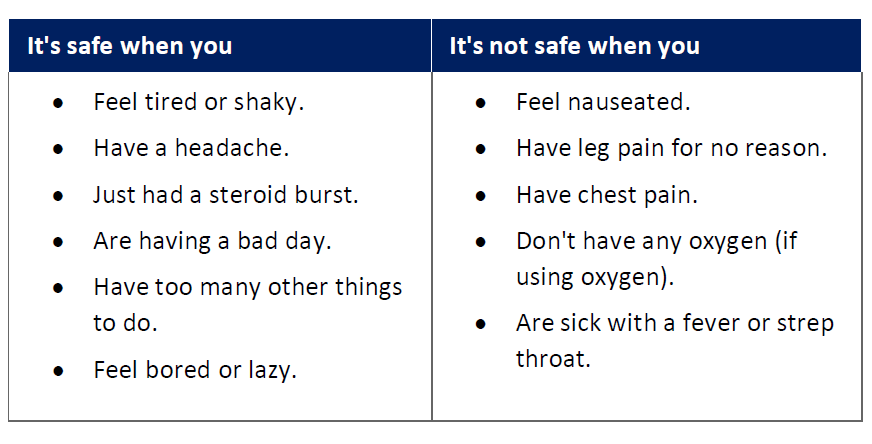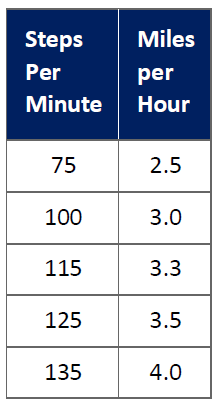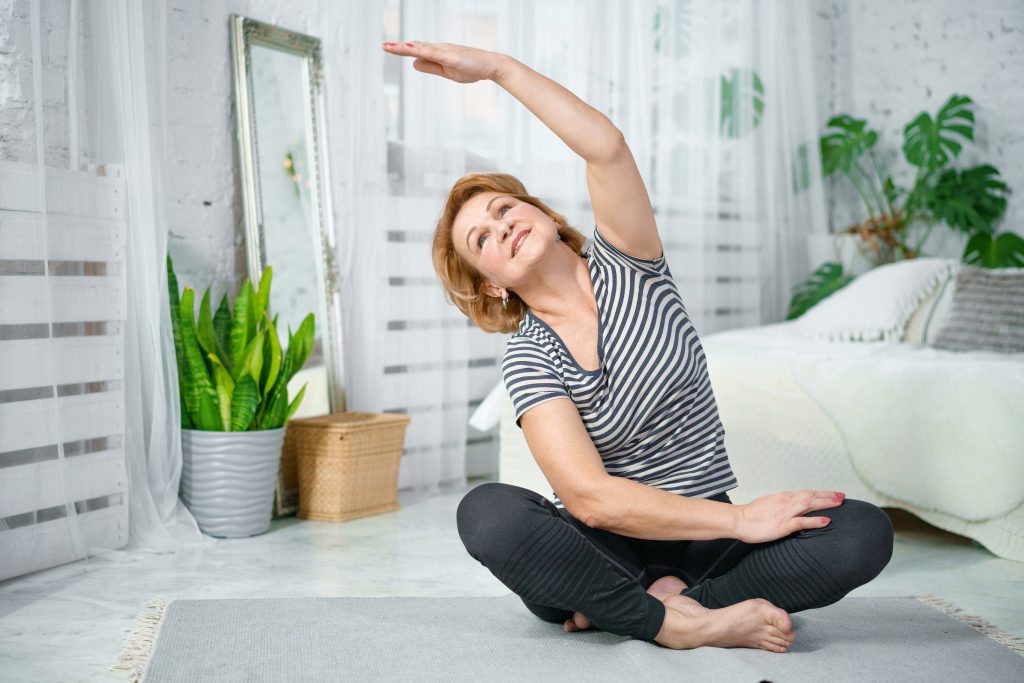Whether you’re on your own or doing a formal Pulmonary Rehabilitation program, safety is very important. Let’s take a look at some questions and answers about exercising with Alpha-1 lung disease.
Download Exercising with Alpha-1 Lung Disease – Questions & Answers as a PDF.
What should I wear?
You don’t need to run to the nearest sporting goods store for exercise clothing. But you should wear clothing that allows you to move freely. Your shoes should be in good shape, and right for your activity.
Do I need to use oxygen with exercise?
Your doctor will tell you if you need to use oxygen during exercise. If you use oxygen regularly, they’ll likely recommend a different flow rate to use during exercise. You should adjust the flow about five minutes before you start, to prevent low oxygen when you first begin.
If you’re exercising in a supervised program, the staff will monitor your oxygen level. They’ll let you know if you need to adjust it.
If you’re exercising on your own, talk to your doctor about adjusting your oxygen if you feel short of breath. (Note: The Borg Scale for Rating Perceived Dyspnea is helpful to rate your level of breathlessness.)
Remember: More oxygen isn’t always the answer. Many people experience shortness of breath when exercising, even with normal oxygen levels. You may just need to slow down.
Oxygen is a “drug” for managing your chronic lung disease. Don’t increase or adjust your oxygen use without talking to your doctor first.
When is exercising with Alpha-1 safe?

Here are some basic rules for exercising during an illness or infection:
- If you are seriously ill, maintain a very low level of activity. This includes self-care, sitting in a chair for meals, and very little walking.
- If you’ve been in the hospital or had a setback, restart your exercise program slowly. Increase your pace and effort level with guidance from your doctor or trainer. Getting back to your exercise program can help your recovery. But, it’s good to ease back into it.
- When you have unusual symptoms, take it easy. Keep it at a 1-2 on the Borg Scale for Rating Perceived Exertion. That means a very small amount of effort.
Exercising with Alpha-1: indoors or outdoors?
You can exercise wherever you want, as long as you’re comfortable. But, when you exercise indoors, you can control factors like temperature, humidity, airflow, and lighting. And, it’s easier to monitor your heart rate and breathing if you don’t have to adjust for environmental factors.
When exercising outdoors, your body responds to air temperature and humidity. If it’s too cold, you may become chilled during your warm up. If it’s too hot, you may become too overheated to complete your workout.
Pay attention to how temperature and humidity affects your daily activities. Do your symptoms flare up when it’s hot and humid or cold and dry? If so, consider working out inside, where you can control your environment.
Should I change my exercise program when I travel?
That depends on two things: access and altitude. If you don’t have access to the equipment you need for your usual workout, you’ll have to adjust. Walking is a great choice for exercising with Alpha-1.
Why? Because you can walk almost anywhere at any time. And it’s easy to adjust your pace so you don’t work too hard.
If you want to know how fast you’re walking, follow these steps:
- Use a stopwatch, the second hand of your watch, or the stopwatch app on your smartphone.
- Count the number of steps you take in 15 seconds at a moderate pace.
- Multiply that number by 4.
- See where that number falls in this table.
How to calculate walking speed

Exercising with Alpha-1 at high altitude
The air we breathe is less dense at higher altitudes. If you travel to a higher altitude than what you’re used to, you may have more symptoms. If you feel more shortness of breath than usual, adjust your pace. It’s OK to take it easy when you’re at high altitudes. You’ll still get the benefits from working out.
If you have an oximeter, you may wish to use it to see if your blood oxygen level has changed at the new altitude. If it has, you can adjust your effort to meet your exercise prescription and your oxygen needs.
When should I take my medicines?
If your doctor recommends it, use your rescue inhaler 15 -30 minutes before exercising.
Does what I eat matter?
Ideally, you shouldn’t eat a heavy meal right before you exercise. Wait at least 30 minutes. Better yet, time your meals so that you have the energy to exercise before eating a meal. If weight management is your goal, you will find that you will eat less after you have completed an exercise session.
Learn more about exercising safely:
Warm-up & stretching
Strength training
Cardio endurance training
For more in-depth information on this topic, please visit the Big Fat Reference Guide (BFRG). If you are enrolled in AlphaNet’s Subscriber Portal, you can access the BFRG here.
Download Exercising with Alpha-1 Lung Disease – Questions & Answers as a PDF.

